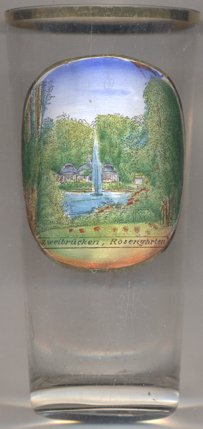

|
| DEUTSCHLAND | GERMANY |
| Bundesland: Rheinland-Pfalz | Rhineland-Palatinate |
| Stadt: Zweibrücken |
Zweibrücken is situated at an elevation of 300 m west of the Pfälzer Wald mountains. Zweibrücken has a population of about 28,000 and is Germany's smallest independent city, i.e. a city not incorporated into an administrative district.
The name Zweibrücken (literally 'two bridges') goes back to a castle of the 12th century, which had a double moat with two bridges. The earliest document mentioning this name dates from 1170. In 1182 Zweibrücken became the centre of a county, and in 1352 it was chartered as a town. The county was partitioned in 1286 but the two parts were administered jointly at first. Zweibrücken obtained the territory of Bitsch (Bitche) from the duchy of Lorraine by exchanging it with its own areas of Morsberg (Marimont-lès-Bénestroff), Linder (Lindre-Haute) and Saargemünd (Sarreguemines). After the partition became final in 1333, Zweibrücken remained the seat of the county of Zweibrücken, while Bitsch became the capital of Zweibrücken-Bitsch (which in 1572/1604 reverted to Lorraine). In 1385 the last count of Zweibrücken sold his territory to the Electors of the Palatinate (Pfalz) from the Wittelsbach dynasty. The palatinate was partitioned in 1410, and Pfalz-Simmern(-Zweibrücken) was created out of Simmern and the Duchy of Zweibrücken. Enlarged by the inheritence of Veldenz and Sponheim, the duchy was partitioned in 1444 into Pfalz-Simmern-Sponheim and Pfalz-Zweibrücken-Veldenz. Until 1477 the residence of the dukes was moved from Mosheim to Zweibrücken. After a partition in 1543 (Pfalz-Veldenz until 1694) Zweibrücken inherited Pfalz-Neuburg in 1556. A further partition of Zweibrücken in 1569 created Pfalz-Zweibrücken, Pfalz-Neuburg (younger line), and Pfalz-Birkenfeld. In 1611 Pfalz-Zweibrücken was partitioned into three further lines (Zweibrücken, Moschellandsberg, and Kleeberg). The Kleeberg line acceeded to the Swedish throne in 1654 (Kings Karl X, XI and XII). From 1714 until 1718 Karl XII of Sweden ceded Zweibrücken to Stanisław Leszczyński, the ousted king of Poland. By 1731 all three Zweibrücken lines had become extinct and the country was inherited by Pfalz-Birkenfeld (now named Pfalz-Zweibrücken-Birkenfeld). In 1799 Pfalz-Birkenfeld inherited the the Electorate (1806 Kingdom) of Bavaria which itself in 1777 had inherited the other Palatinate lines.
However, large parts of the Palatinate including Zweibrücken and Birkenfeld had been occupied by France in 1793. In 1801 Zweibrücken (French: Deux-Ponts) became the seat of a sous-préfecture in the département Mont-Tonnerre (German: Donnersberg). Only after the Congress of Vienna in 1815, most parts of the Palatinate left of the river Rhine which had been occupied by France were returned in 1816 to the Kingdom of Bavaria whereas Birkenfeld was awarded to the Grand Duchy of Oldenburg.
After World War I, Zweibrücken was occupied by France between 1918 and 1930. After the outbreak of World War II the town was evacuated between 1939 and 1940. In 1945 Zweibrücken was almost completely destroyed by an allied bomb raid and had to be rebuilt after the war. In 1946 Zweibrücken became part of the newly-founded German state of Rheinland-Pfalz.
During the 20th century the municipality of Zweibrücken was enlarged by the incorporation of the neighbouring communities of Bubenhausen and Ernstweiler (1926), Ixheim and Niederauerbach (1938), and Mittelbach-Hengstbach, Mörsbach, Oberauerbach, Rimschweiler and Wattweiler (1972).

The  Wittelsbacher-Brunnen-Denkmal (fountain monument) [left, no. 1932]
was created by the sculptor August Drumm, honorary citizen of Zweibrücken. Drumm died in 1904,
shortly after the completion of the model for the monument.
The fountain was originally located on the square in front of the residence (Schlossplatz).
Today the monument is located in Mannlicherplatz.
Wittelsbacher-Brunnen-Denkmal (fountain monument) [left, no. 1932]
was created by the sculptor August Drumm, honorary citizen of Zweibrücken. Drumm died in 1904,
shortly after the completion of the model for the monument.
The fountain was originally located on the square in front of the residence (Schlossplatz).
Today the monument is located in Mannlicherplatz.

The square,  Herzogsplatz [left, no. 1977], in today's spelling
Herzogplatz, is located between Herzogstraße and Hallplatz.
Herzogsplatz [left, no. 1977], in today's spelling
Herzogplatz, is located between Herzogstraße and Hallplatz.

The  Rosengarten [left, no. 3399] is one of the largest parks
(covering more than 50,000 m²) in Europe and the world's third largest rosarium. The park was inaugurated in 1914
but was completely destroyed by bomb raid during World War II in March 1945. Reconstructed, it opened again in 1948.
Rosengarten [left, no. 3399] is one of the largest parks
(covering more than 50,000 m²) in Europe and the world's third largest rosarium. The park was inaugurated in 1914
but was completely destroyed by bomb raid during World War II in March 1945. Reconstructed, it opened again in 1948.
![[scale]](lineal.jpg)